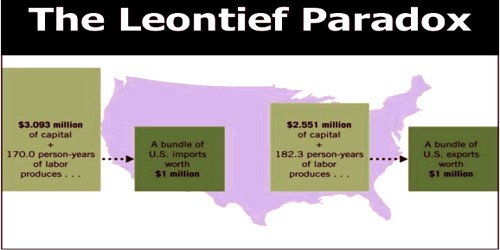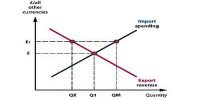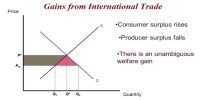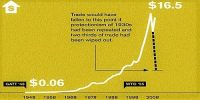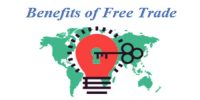Leontief Paradox of International Trade
In the early 1950s, Russian-born American economist Wassily W. Leontief studied the, US economy closely and noted that the United States was abundant in capital and, therefore, should export more capital-intensive goods. However, his research using actual data showed the opposite: the United States was importing more capital-intensive goods. In 1953 Wassily Leontief published the results of the mainly renowned experiential investigations in economics, an attempt to test the reliability of the H-O Model with the U.S. trade patterns.
According to the factor proportions theory, the United States should have been importing labor-intensive goods, but instead, it was actually exporting them. His analysis became known as the Leontief Paradox because it was the reverse of what was expected by the factor proportions theory. This econometric find was the result of Wassily W. Leontief’s attempt to test the Heckscher–Ohlin theory (“H–O theory”) empirically. It was measured that a country will be liable to export those commodities which use its abundant factors of manufacture intensively and import those which use its inadequate issue intensively.
Leontief Paradox is the concept that countries with a great deal of capital available import capital intensive commodities and export labor-intensive commodities.
Leontief’s objectives were:
- to prove that the H-O Model was correct; and
- to show that the U.S. exports were capital intensive.
Leontief developed a 1947 input-output table for the U.S. to establish the capital-labor ratios used in the production of U.S. exports and imports. In one of the most broadly discussed tests of the factor proportions theory, Leontief attempted to expose the relative factor proportions structure of U.S. contribution in international trade. He found that the U.S. exports used a capital-labor ratio of $13,991 per man-year, whereas import substitutes used a ratio of $18,184 per man-year.
In subsequent years, economists have noted historically at that point in time, labor in the United States was available in steady supply and more productive than in many other countries; hence it made sense to export labor-intensive goods. Over the decades, many economists have used theories and data to explain and minimize the impact of paradox.
By general approval, the United States is the only country that is most abundantly capable of capital. Therefore, one would expect the United States to export assets thorough goods and import labor demanding goods.
However, what remains clear is that international trade is complex and is impacted by numerous and often-changing factors. Trade cannot be explained neatly by one single theory, and more importantly, our understanding of international trade theories continues to evolve.
Assumption
The argument of the Leontief paradox has barely been competent to ascertain firm conclusions. It has provided a good deal of imminent into the international trade situation of the U.S., but it has almost not helped to ascertain or disprove the H.O. theory of global trade.
Some economists pointed out that Leontief ignored worker’s proficiency and this could be seen as a key justification if we regard that human capital is the US’s comparatively profuse issue.
The Leontief Paradox evoked a prevalent reaction from academicians. Several attempts were made by them to either protect the paradox or determine its rational flaws and verify it wrong.
Leontief recognized that allowing for only labor and capital as inputs of a nation is impractical and therefore he highlighted a country’s endowment of natural resources as a critical component in production.
Re-estimation of factor-intensity of the US exports and imports by incorporating one or more of the additional factors has been found to yield varying results, from underneath Leontief Paradox to contradicting it or weakening it.
The reasoning used by Leontief has a logical error in the logic that it is an application of a two-factor model to a multi-factor circumstance. It also ignores the fact that some trade-items are severe in usual resources.
